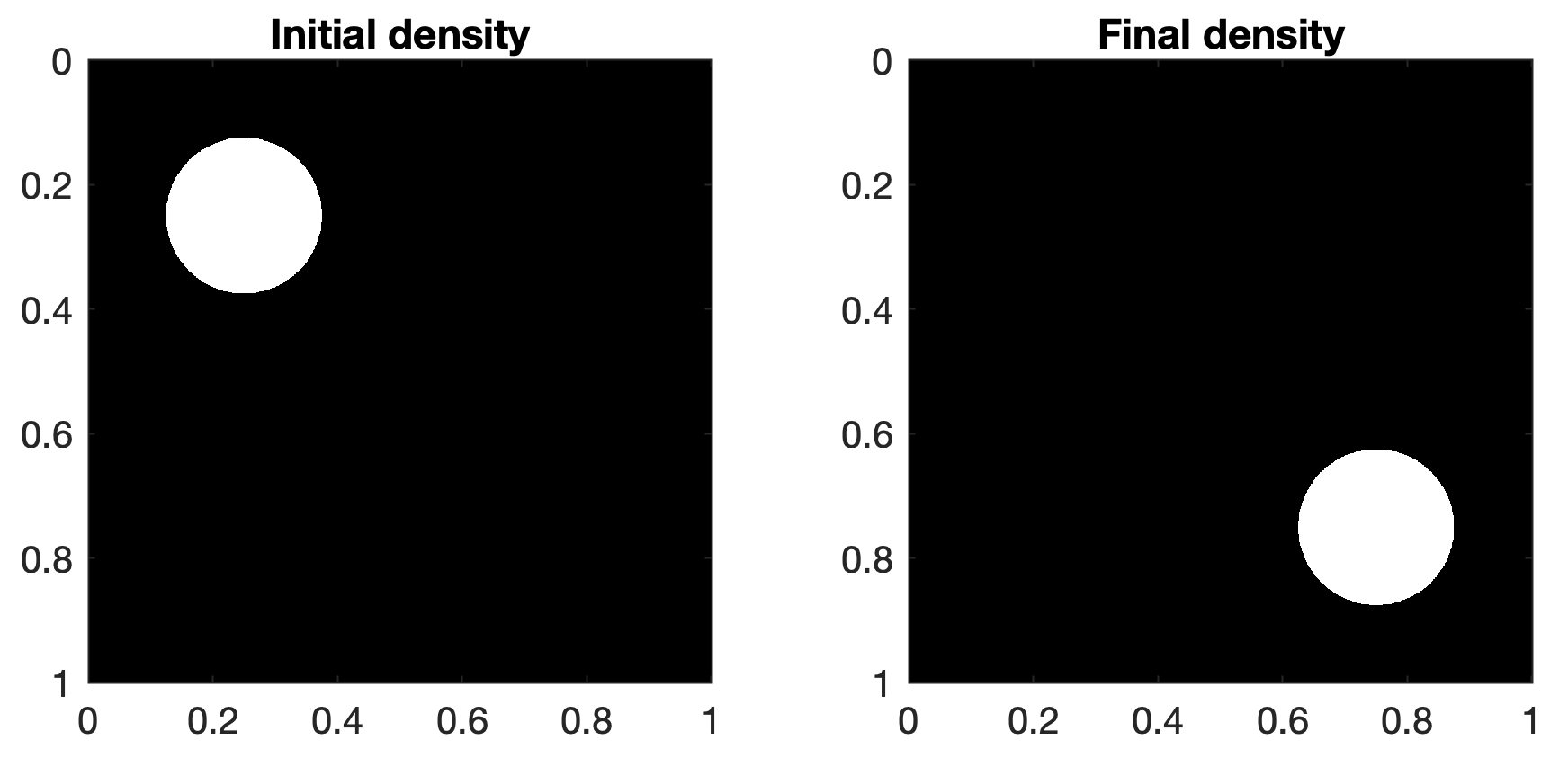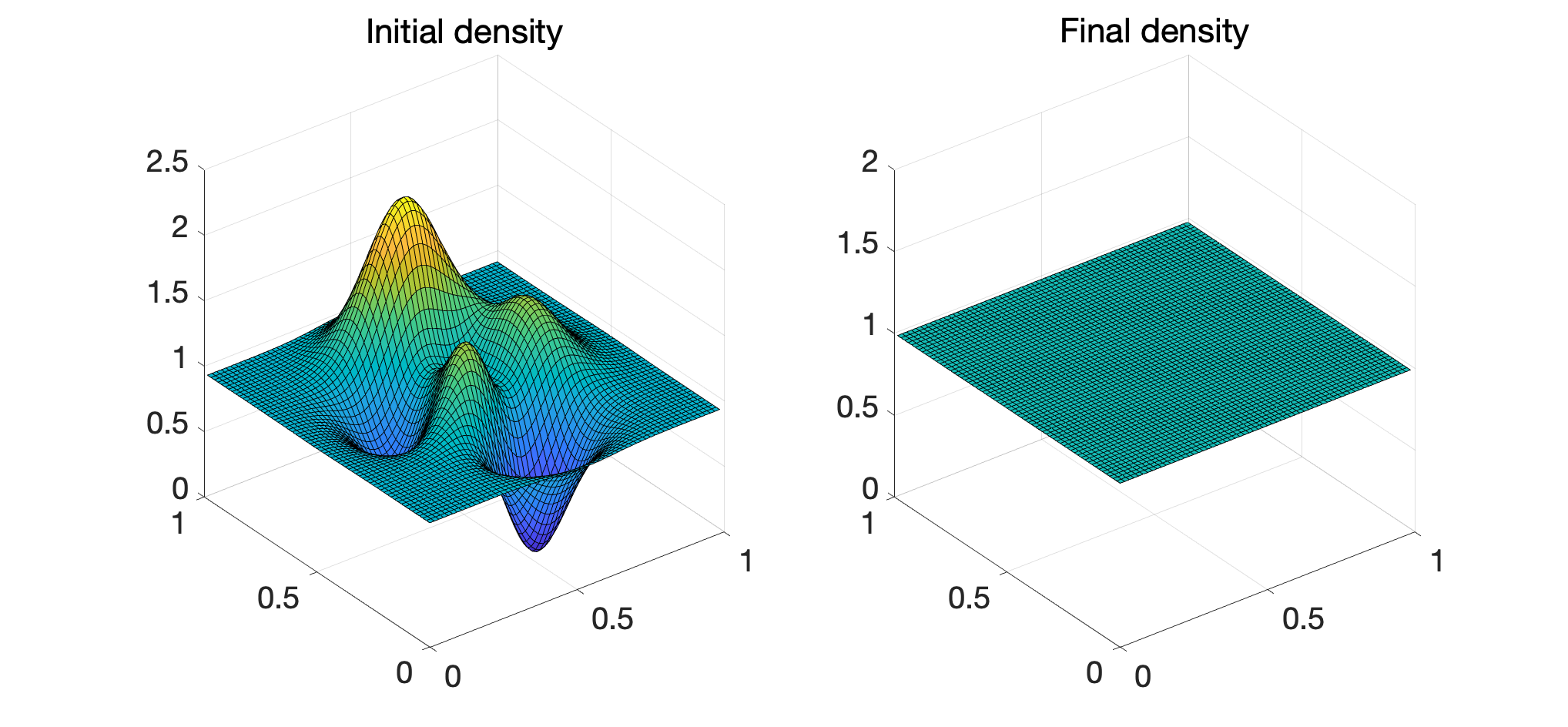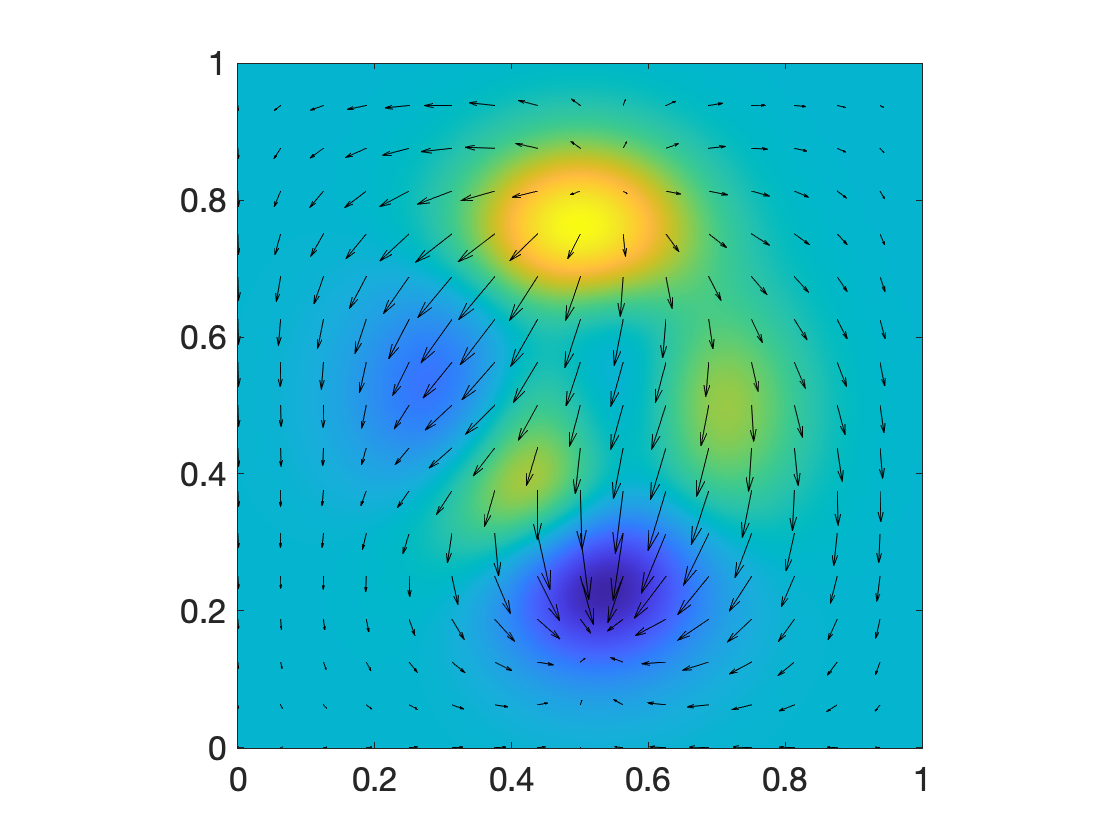The back-and-forth method¶
This page provides documentation for the source code used in the paper A fast approach to optimal transport: The back-and-forth method.
The original code was written in C. A MATLAB wrapper is provided at https://github.com/Math-Jacobs/bfm.
Introduction¶
We are interested in the optimal transport problem
on the unit square
The code solves the dual Kantorovich problem
over functions
Python¶
The simplest way to use the Python code is to run this notebook on Google Colab.
The notebook is also available on the GitHub repository.
Alternatively, to install the Python bindings on your machine, first run in a terminal
git clone https://github.com/Math-Jacobs/bfm
and then install the Python bindings by running
pip install ./bfm/python
You may then directly run example.py.
MATLAB¶
Installation¶
Requirements: FFTW (download here), MATLAB.
Download the C MEX file w2.c here or by cloning the GitHub repository.
Compile it: in a MATLAB session run
mex -O CFLAGS="\$CFLAGS -std=c99" -lfftw3 -lm w2.c
This will produce a MEX w2 function that you can use in MATLAB. You may need to use flags -I and -L to link to the FFTW3 library, e.g. mex -O CFLAGS="$CFLAGS -std=c++11" w2.c -lfftw3 -I/usr/local/include. See this page for more information on how to compile MEX files.
Usage¶
In a MATLAB session, run the command
[phi, psi] = w2(mu, nu, numIters, sigma);
Input:
muandnuare twonumItersis the total number of iterations.sigmais the initial step size of the gradient ascent iterations.
Output:
phiandpsiare
Example 1¶
Let us first compute the optimal transport between the characterstic function of a disk and its translate. We discretize the problem with ~1 million points (
n = 1024;
[x,y] = meshgrid(linspace(0.5/n, 1-0.5/n, n));
mu = zeros(n);
idx = (x-0.25).^2 + (y-0.25).^2 < 0.125^2;
mu(idx) = 1;
mu = mu * n^2/sum(mu(:));
nu = zeros(n);
idx = (x-0.75).^2 + (y-0.75).^2 < 0.125^2;
nu(idx) = 1;
nu = nu * n^2/sum(nu(:));
subplot(1,2,1)
imagesc(mu, 'x',[0,1], 'y',[0,1]);
title('Initial density')
subplot(1,2,2)
imagesc(nu, 'x',[0,1], 'y',[0,1]);
title('Final density')

Here the densities are renormalized so that
numIters = 10;
sigma = 8.0 / max(max(mu(:)), max(nu(:)));
tic;
[phi,psi] = w2(mu, nu, numIters, sigma);
toc
Output:
FFT setup time: 0.01s
iter 0, W2 value: 2.414694e-01
iter 5, W2 value: 2.500000e-01
iter 10, W2 value: 2.500000e-01
Elapsed time is 3.432973 seconds.
Example 2¶
Let’s compute the optimal transport between the MATLAB peaks function and the uniform measure, on the 2d domain
We discretize the problem with ~1 million points (
n = 1024;
[x,y] = meshgrid(linspace(0,1,n));
mu = peaks(n);
mu = mu - min(mu(:));
mu = mu * n^2/sum(mu(:));
nu = ones(n);
s = 16; % plotting stride
subplot(1,2,1)
surf(x(1:s:end,1:s:end), y(1:s:end,1:s:end), mu(1:s:end,1:s:end))
title('Initial density')
subplot(1,2,2)
surf(x(1:s:end,1:s:end), y(1:s:end,1:s:end), nu(1:s:end,1:s:end))
title('Final density')

Then run the back-and-forth solver:
numIters = 20;
sigma = 8.0 / max(max(mu(:)), max(nu(:)));
tic;
[phi,psi] = w2(mu, nu, numIters, sigma);
toc
Output:
FFT setup time: 0.02s
iter 0, W2 value: -1.838164e-02
iter 5, W2 value: 9.791770e-04
iter 10, W2 value: 9.793307e-04
iter 15, W2 value: 9.793364e-04
iter 20, W2 value: 9.793362e-04
Elapsed time is 10.016858 seconds.
Finally compute the optimal transport map
and display the displacement
[mx, my] = gradient(-psi, 1/n);
figure;
imagesc(mu,'x',[0,1],'y',[0,1]);
axis square
set(gca,'YDir','normal')
hold on
s = 64;
quiver(x(1:s:end,1:s:end), y(1:s:end,1:s:end), ...
mx(1:s:end,1:s:end), my(1:s:end,1:s:end), ...
0, 'Color','k');

References¶
[1] Matt Jacobs and Flavien Léger. A fast approach to optimal transport: The back-and-forth method. Numerische Mathematik (2020): 1-32.
